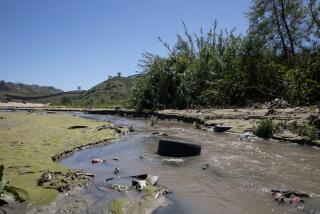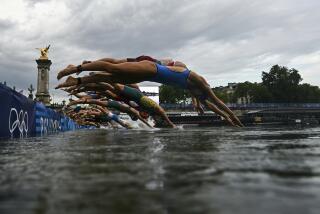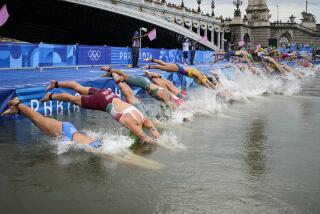Project to measure danger of murky Chicago River
- Share via
CHICAGO — Most of the water in the Chicago River is treated sewage loaded with bacteria, but officials contend they shouldn’t be forced to clean up the waterway unless a newly commissioned study finds that people are getting sick from the murky flow.
Under pressure from Democratic Mayor Richard M. Daley and others to turn the stagnant canals into civic amenities, the Metropolitan Water Reclamation District asked researchers to survey people who dip a canoe or kayak into the river during the next year. The goal is to compare their rates of illness with the rates for people who swim in Lake Michigan or have no contact with either body of water.
The first major push to enroll people in the study comes Sunday, when more than 450 participants in the Chicago River Flatwater Classic paddle a stretch of the waterway from Clark Park on the North Side to Ping Tom Park in Chinatown.
Until the district commissioned the study, the Illinois Environmental Protection Agency had been on track to move forward with standards that for the first time would limit the amount of bacteria allowed in the river. Environmental groups complain that the study could delay or scuttle those efforts.
District officials are drawing up plans to disinfect the region’s treated sewage, something most other large cities already do. But they also argue that it might not be worth it to clean up the river.
“Thank you, Mr. Mayor, for calling for disinfection,” said Richard Lanyon, the district’s general superintendent. “If he wants to put up the money to make it happen, that’s great. But we still don’t know if there are any health risks.” To answer that question, the University of Illinois at Chicago hopes to enlist 9,000 people in the study during the next year by approaching paddlers, boaters and swimmers along the river and lake.
Researchers will ask participants to fill out a questionnaire on the spot, then follow up during the next three weeks to see whether they developed any stomach ailments, skin rashes or ear infections. In an attempt to trace the cause of any illnesses, nurses will be sent out to collect stool samples.
The project is another sign of changing attitudes about an erstwhile prairie stream that for more than a century has been seen as little more than an industrialized sewage canal.
Chicago reversed the flow of its river in 1900 to keep the burgeoning city’s waste out of Lake Michigan, its source of drinking water. For decades the river was fenced off to prevent human contact and exempt from the toughest requirements of the Clean Water Act.
But with water quality steadily improving, people have been increasingly drawn to the dredged and straightened channels for recreation.
Environmental advocates say there’s no doubt that bacteria levels in the Chicago River are higher than what is allowed in other waterways. They note that Chicago is the only large U.S. city that doesn’t disinfect its treated wastewater, a throwback to days when officials assumed people wouldn’t come near the river.
“Times have changed and the standards need to change with the times,” said Margaret Frisbee, executive director of Friends of the Chicago River, an advocacy group that organized Sunday’s canoe race. “This study will show us what we already know: The river isn’t clean enough for human contact.”
Los Angeles, New York City and most other major cities douse treated sewage with chlorine to kill bacteria, then strip out the toxic chemical before dumping what’s left into waterways. Using chlorine has been ruled out in Chicago, mostly because of security concerns about keeping large amounts of the chemical on hand. The alternative is to zap wastewater with ultraviolet light, which would speed up the natural, germ-killing effects of sunlight.
Officials at the Metropolitan Water Reclamation District say it is inappropriate to judge the river by standards based in part on studies of beachgoers who swim in the water, rather than float above it with an occasional splash.
They estimate it would cost taxpayers $623 million to install equipment that would meet more stringent water quality standards. The U.S. Environmental Protection Agency commissioned its own report that concluded the cost would be considerably less -- about $242 million.
Cleaning up the river almost assuredly would require disinfection of wastewater discharged by three huge treatment plants that handle sewage from Chicago and most Cook County suburbs. The treatment plants, along with overloaded storm drains, are the main source of water in the river.
Bacteria levels, relatively low upstream from the treatment plants, spike just downstream and remain high for several miles. The U.S. EPA found that the amount of bacteria in water churning out of the North Side Treatment Plant, at Howard Street and McCormick Boulevard, is 407 times higher than disinfected wastewater that Philadelphia pumps into the Delaware River.
“Our intent is to get disinfection technology in place at those treatment plants as quickly as possible,” said Toby Frevert, water quality manager at the Illinois EPA.
“Of course, that could change if the science suggests that taxpayer dollars would be better spent on other environmental improvements.”
More to Read
Sign up for Essential California
The most important California stories and recommendations in your inbox every morning.
You may occasionally receive promotional content from the Los Angeles Times.










